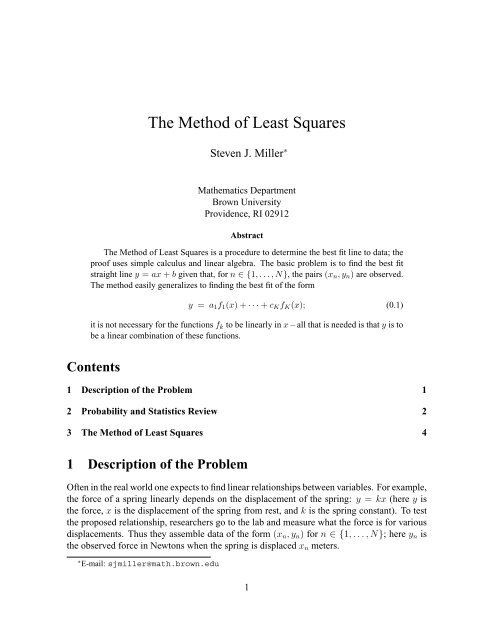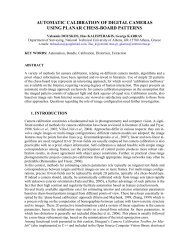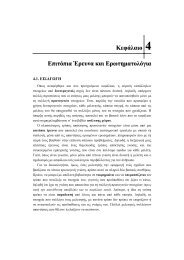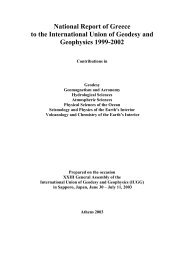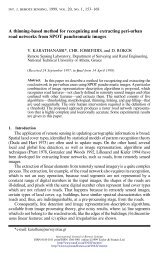The Method of Least Squares
The Method of Least Squares
The Method of Least Squares
Create successful ePaper yourself
Turn your PDF publications into a flip-book with our unique Google optimized e-Paper software.
<strong>The</strong> <strong>Method</strong> <strong>of</strong> <strong>Least</strong> <strong>Squares</strong>Steven J. Miller ∗Mathematics DepartmentBrown UniversityProvidence, RI 02912Abstract<strong>The</strong> <strong>Method</strong> <strong>of</strong> <strong>Least</strong> <strong>Squares</strong> is a procedure to determine the best fit line to data; thepro<strong>of</strong> uses simple calculus and linear algebra. <strong>The</strong> basic problem is to find the best fitstraight line y = ax + b given that, for n ∈ {1, . . . , N}, the pairs (x n , y n ) are observed.<strong>The</strong> method easily generalizes to finding the best fit <strong>of</strong> the formy = a 1 f 1 (x) + · · · + c K f K (x); (0.1)it is not necessary for the functions f k to be linearly in x – all that is needed is that y is tobe a linear combination <strong>of</strong> these functions.Contents1 Description <strong>of</strong> the Problem 12 Probability and Statistics Review 23 <strong>The</strong> <strong>Method</strong> <strong>of</strong> <strong>Least</strong> <strong>Squares</strong> 41 Description <strong>of</strong> the ProblemOften in the real world one expects to find linear relationships between variables. For example,the force <strong>of</strong> a spring linearly depends on the displacement <strong>of</strong> the spring: y = kx (here y isthe force, x is the displacement <strong>of</strong> the spring from rest, and k is the spring constant). To testthe proposed relationship, researchers go to the lab and measure what the force is for variousdisplacements. Thus they assemble data <strong>of</strong> the form (x n , y n ) for n ∈ {1, . . . , N}; here y n isthe observed force in Newtons when the spring is displaced x n meters.∗ E-mail: sjmiller@math.brown.edu1
100806040205 10 15 20Figure 1: 100 “simulated” observations <strong>of</strong> displacement and force (k = 5).Unfortunately, it is extremely unlikely that we will observe a perfect linear relationship.<strong>The</strong>re are two reasons for this. <strong>The</strong> first is experimental error; the second is that the underlyingrelationship may not be exactly linear, but rather only approximately linear. See Figure 1 fora simulated data set <strong>of</strong> displacements and forces for a spring with spring constant equal to 5.<strong>The</strong> <strong>Method</strong> <strong>of</strong> <strong>Least</strong> <strong>Squares</strong> is a procedure, requiring just some calculus and linear algebra,to determine what the “best fit” line is to the data. Of course, we need to quantify whatwe mean by “best fit”, which will require a brief review <strong>of</strong> some probability and statistics.A careful analysis <strong>of</strong> the pro<strong>of</strong> will show that the method is capable <strong>of</strong> great generalizations.Instead <strong>of</strong> finding the best fit line, we could find the best fit given by any finite linearcombinations <strong>of</strong> specified functions. Thus the general problem is given functions f 1 , . . . , f K ,find values <strong>of</strong> coefficients a 1 , . . . , a K such that the linear combinationis the best approximation to the data.y = a 1 f 1 (x) + · · · + a K f K (x) (1.1)2 Probability and Statistics ReviewWe give a quick introduction to the basic elements <strong>of</strong> probability and statistics which we needfor the <strong>Method</strong> <strong>of</strong> <strong>Least</strong> <strong>Squares</strong>; for more details see [BD, CaBe, Du, Fe, Kel, LF, MoMc].Given a sequence <strong>of</strong> data x 1 , . . . , x N , we define the mean (or the expected value) to be2
(x 1 + · · · + x N )/N. We denote this by writing a line above x: thusx =1 NN∑x n . (2.2)n=1<strong>The</strong> mean is the average value <strong>of</strong> the data.Consider the following two sequences <strong>of</strong> data: {10, 20, 30, 40, 50} and {30, 30, 30, 30, 30}.Both sets have the same mean; however, the first data set has greater variation about the mean.This leads to the concept <strong>of</strong> variance, which is a useful tool to quantify how much a set <strong>of</strong> datafluctuates about its mean. <strong>The</strong> variance <strong>of</strong> {x 1 , . . . , x N }, denoted by σ 2 x, isσ 2 x = 1 NN∑(x i − x) 2 ; (2.3)n=1the standard deviation σ x is the square root <strong>of</strong> the variance:σ x = √ 1 N∑(x i − x)N2 . (2.4)n=1Note that if the x’s have units <strong>of</strong> meters then the variance σ 2 x has units <strong>of</strong> meters 2 , and thestandard deviation σ x and the mean x have units <strong>of</strong> meters. Thus it is the standard deviationthat gives a good measure <strong>of</strong> the deviations <strong>of</strong> the x’s around their mean.<strong>The</strong>re are, <strong>of</strong> course, alternate measures one can use. For example, one could consider1NN∑(x n − x). (2.5)n=1Unfortunately this is a signed quantity, and large positive deviations can cancel with largenegatives. In fact, the definition <strong>of</strong> the mean immediately implies the above is zero! This,then, would be a terrible measure <strong>of</strong> the variability in data, as it is zero regardless <strong>of</strong> what thevalues <strong>of</strong> the data are.We can rectify this problem by using absolute values. This leads us to consider1NN∑|x n − x|. (2.6)n=1While this has the advantage <strong>of</strong> avoiding cancellation <strong>of</strong> errors (as well as having the sameunits as the x’s), the absolute value function is not a good function analytically. It is notdifferentiable. This is primarily why we consider the standard deviation (the square root <strong>of</strong>the variance) – this will allow us to use the tools from calculus.3
We can now quantify what we mean by “best fit”. If we believe y = ax+b, then y−(ax+b)should be zero. Thus given observationswe look at{(x 1 , y 1 ), . . . , (x N , y N )}, (2.7){y 1 − (ax 1 + b), . . . , y N − (ax N + b)}. (2.8)<strong>The</strong> mean should be small (if it is a good fit), and the variance will measure how good <strong>of</strong> a fitwe have.Note that the variance for this data set isσy−(ax+b) 2 = 1 N∑(y n − (ax n + b)) 2 . (2.9)Nn=1Large errors are given a higher weight than smaller errors (due to the squaring). Thus our procedurefavors many medium sized errors over a few large errors. If we used absolute values tomeasure the error (see equation (2.6)), then all errors are weighted equally; however, the absolutevalue function is not differentiable, and thus the tools <strong>of</strong> calculus become inaccessible.3 <strong>The</strong> <strong>Method</strong> <strong>of</strong> <strong>Least</strong> <strong>Squares</strong>Given data {(x 1 , y 1 ), . . . , (x N , y N )}, we may define the error associated to saying y = ax + bbyN∑E(a, b) = (y n − (ax n + b)) 2 . (3.10)n=1This is just N times the variance <strong>of</strong> the data set {y 1 −(ax 1 +b), . . . , y n −(ax N +b)}. It makesno difference whether or not we study the variance or N times the variance as our error, andnote that the error is a function <strong>of</strong> two variables.<strong>The</strong> goal is to find values <strong>of</strong> a and b that minimize the error. In multivariable calculus welearn that this requires us to find the values <strong>of</strong> (a, b) such that∂E∂a = 0, ∂E∂b= 0. (3.11)Note we do not have to worry about boundary points: as |a| and |b| become large, the fit willclearly get worse and worse. Thus we do not need to check on the boundary.Differentiating E(a, b) yields∂E∂a∂E∂b==N∑2 (y n − (ax n + b)) · (−x n )n=1N∑2 (y n − (ax n + b)) · 1. (3.12)n=14
Setting ∂E/∂a = ∂E/∂b = 0 (and dividing by 2) yieldsN∑(y n − (ax n + b)) · x n = 0n=1N∑(y n − (ax n + b)) = 0. (3.13)n=1We may rewrite these equations as(∑ N) ( N)∑a + x n b =n=1x 2 nn=1(∑ N) ( N)∑x n a + 1 b =n=1n=1N∑x n y nn=1N∑y n . (3.14)We have obtained that the values <strong>of</strong> a and b which minimize the error (defined in (3.10))satisfy the following matrix equation:⎛ ∑ N ∑ Nn=1 x2 n n=1 x ⎞ ⎛ ⎞ ⎛ ∑n aNn=1 x ⎞ny n⎝⎠ ⎝ ⎠ = ⎝⎠ . (3.15)∑ Nn=1 x ∑ Nn n=1 1 ∑bNn=1 y nWe will show the matrix is invertible, which implies⎛ ⎞ ⎛ ∑aN ∑ Nn=1 x2 n n=1 x ⎞n⎝ ⎠ = ⎝⎠∑bNn=1 x ∑ Nn n=1 1As−1 ⎛Denote the matrix by M. <strong>The</strong> determinant <strong>of</strong> M isN∑ N∑ N∑det M = x 2 n · 1 − x n ·we find thatn=1x =det M = Nn=11Nn=1⎝n=1∑ Nn=1 x ny n∑ Nn=1 y n⎞⎠ . (3.16)N∑x n . (3.17)n=1N∑x n , (3.18)n=1N∑x 2 n − (Nx) 2n=1(= N 2 1N= N 2 · 1N5)N∑x 2 n − x 2n=1N∑(x n − x) 2 , (3.19)n=1
where the last equality follows from simple algebra. Thus, as long as all the x n are not equal,det M will be non-zero and M will be invertible.Thus we find that, so long as the x’s are not all equal, the best fit values <strong>of</strong> a and b areobtained by solving a linear system <strong>of</strong> equations; the solution is given in (3.16).Remark 3.1. <strong>The</strong> data plotted in Figure 1 was obtained by letting x n = 5 + .2n and thenletting y n = 5x n plus an error randomly drawn from a normal distribution with mean zero andstandard deviation 4 (n ∈ {1, . . . , 100}). Using these values, we find a best fit line <strong>of</strong>y = 4.99x + .48; (3.20)thus a = 4.99 and b = .48. As the expected relation is y = 5x, we expected a best fit value <strong>of</strong>a <strong>of</strong> 5 and b <strong>of</strong> 0.While our value for a is very close to the true value, our value <strong>of</strong> b is significantly <strong>of</strong>f.We deliberately chose data <strong>of</strong> this nature to indicate the dangers in using the <strong>Method</strong> <strong>of</strong> <strong>Least</strong><strong>Squares</strong>. Just because we know 4.99 is the best value for the slope and .48 is the best valuefor the y-intercept does not mean that these are good estimates <strong>of</strong> the true values. <strong>The</strong> theoryneeds to be supplemented with techniques which provide error estimates. Thus we want toknow something like, given this data, there is a 99% chance that the true value <strong>of</strong> a is in(4.96, 5.02) and the true value <strong>of</strong> b is in (−.22, 1.18); this is far more useful than just knowingthe best fit values.If instead we usedN∑E abs (a, b) = |y n − (ax n + b)| , (3.21)n=1then numerical techniques yield that the best fit value <strong>of</strong> a is 5.03 and the best fit value <strong>of</strong> bis less than 10 −10 in absolute value. <strong>The</strong> difference between these values and those from the<strong>Method</strong> <strong>of</strong> <strong>Least</strong> <strong>Squares</strong> is in the best fit value <strong>of</strong> b (the least important <strong>of</strong> the two parameters),and is due to the different ways <strong>of</strong> weighting the errors.Exercise 3.2. Generalize the method <strong>of</strong> least squares to find the best fit quadratic to y = ax 2 +bx+c (or more generally the best fit degree m polynomial to y = a m x m +a m−1 x m−1 +· · ·+a 0 ).While for any real world problem, direct computation determines whether or not the resultingmatrix is invertible, it is nice to be able to prove the determinant is always non-zer<strong>of</strong>or the best fit line (if all the x’s are not equal).Exercise 3.3. If the x’s are not all equal, must the determinant be non-zero for the best fitquadratic or the best fit cubic?Looking at our pro<strong>of</strong> <strong>of</strong> the <strong>Method</strong> <strong>of</strong> <strong>Least</strong> <strong>Squares</strong>, we note that it was not essential thatwe have y = ax + b; we could have had y = af(x) + bg(x), and the arguments would have6
proceeded similarly. <strong>The</strong> difference would be that we would now obtain⎛ ∑ Nn=1 f(x ∑n) 2 Nn=1 f(x ⎞ ⎛ ⎞ ⎛ ∑n)g(x n ) aNn=1 f(x n)y n⎝⎠ ⎝ ⎠ = ⎝∑ Nn=1 f(x ∑n)g(x n ) Nn=1 g(x ∑n) 2 bNn=1 g(x n)y n⎞⎠ . (3.22)Exercise 3.4. Consider the generalization <strong>of</strong> the <strong>Method</strong> <strong>of</strong> <strong>Least</strong> <strong>Squares</strong> given in (3.22).Under what conditions is the matrix invertible?Exercise 3.5. <strong>The</strong> method <strong>of</strong> pro<strong>of</strong> generalizes further to the case when one expects y is alinear combination <strong>of</strong> K fixed functions. <strong>The</strong> functions need not be linear; all that is requiredis that we have a linear combination, say a 1 f 1 (x) + · · · + a K f K (x). One then determinesthe a 1 , . . . , a K that minimize the variance (the sum <strong>of</strong> squares <strong>of</strong> the errors) by calculus andlinear algebra. Find the matrix equation that the best fit coefficients (a 1 , . . . , a K ) must satisfy.Exercise 3.6. Consider the best fit line from the <strong>Method</strong>∑<strong>of</strong> <strong>Least</strong> <strong>Squares</strong>, so the best fit valuesare given by (3.16). Is the point (x, y), where x = 1 Nn n=1 x n and y = ∑ Nn=1 y n, on the bestfit line? In other words, does the best fit line go through the “average” point?References[BD][CaBe]P. Bickel and K. Doksum, Mathematical Statistics: Basic Ideas and Selected Topics,Holden-Day, San Francisco, 1977.G. Casella and R. Berger, Statistical Inference, 2nd edition, Duxbury AdvancedSeries, Pacific Grove, CA, 2002.[Du] R. Durrett, Probability: <strong>The</strong>ory and Examples, 2nd edition, Duxbury Press, 1996.[Fe][Kel][LF][MoMc]W. Feller, An Introduction to Probability <strong>The</strong>ory and Its Applications, 2nd edition,Vol. II, John Wiley & Sons, New York, 1971.D. Kelley, Introduction to Probability, Macmillan Publishing Company, London,1994.R. Larson and B. Farber, Elementary Statistics: Picturing the World, Prentice-Hall,Englewood Cliffs, NJ, 2003.D. Moore and G. McCabe, Introduction to the Practice <strong>of</strong> Statistics, W. H. Freemanand Co., London, 2003.7


